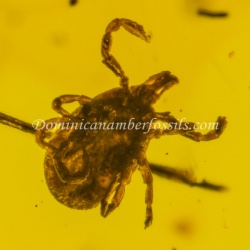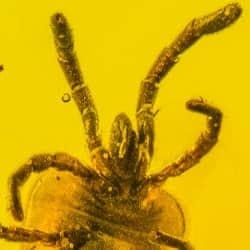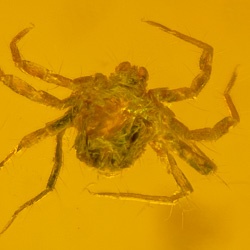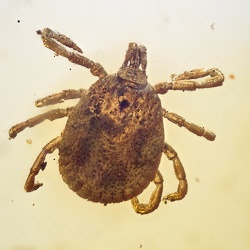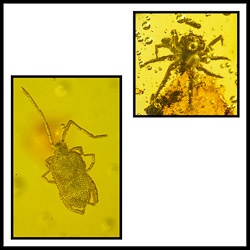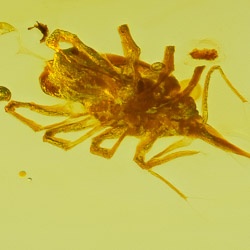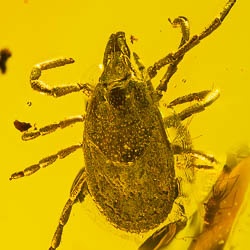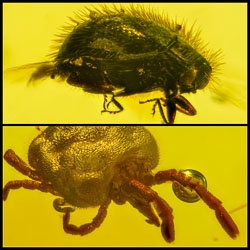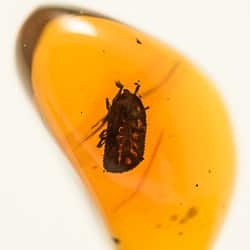Filters
Acarina Ixodidae Hard tick V1658
Extremely Rare - Highly Collectible Inclusion
Live Like Hard Tick (Ixodidae)
Amazing Specimen Very Well Displayed on Clear & Solid Amber Piece
A "Must Have" in all serious collection!!!
Contains Several Other Specimens Such as Coleoptera, Dipteras, Spider...
Suitable also for Super Exclusive Jewellery
Ticks Description & Behavior
Ticks are small arachnids, belonging to the subclass Acari. Ticks are ectoparasites who live by feeding on the blood of mammals, birds and reptiles and are vectors of various diseases that affect humans and animals. Extant ticks are widely distributed around the world, especially in warm, humid climates. The two major families of Ticks are Ixodidae, or Hard Ticks, with more than 700 species and Argasidae or Soft Ticks, with 208 species.
Hard Ticks have a hard scutum, like a shield, on their dorsal surfaces. The scutum covers most of the dorsal surface of the male. It is much smaller in the female, allowing her to expand enormously as she feeds and becomes engorged with blood. The mouthparts of Hard Ticks have a beak-like structure, projecting forwards from the body, that can be seen from above.
Soft Ticks have a soft, wrinkled exoskeleton and their mouthparts, consisting of two palps and one hypostome, are located on the underside of the body and are not visible when viewed from above.
All Ticks have four life stages: Egg, Larva, Nymph and Adult.
Larval Ticks hatch with six legs and acquire the other two when, after a blood meal, they molt into the Nymph Stage.
In the Nymphal and Adult stages, Ticks have eight legs, each one has seven segments and is tipped with a pair of claws. Hard Ticks have only one Nymphal Stage. They stay attached to feed on their hosts for several days to weeks. Some species stay with the same host for life, but most Hard Ticks have two or three hosts.
In two-host case, Ticks Larvae and Nymphs feed and develop on the same host. Nymphs leave the host after the meal and develop into adults which will feed on a new host.
In three-host case, Tick each stage of life cycle feed on a different host species. In general the size of the host will increase with each feed as the size of the Tick increases.
Ixodidae usually mate while on host animals. After mating, blood-fed female adults drop from the host, lay a large mass of some thousand eggs in protected habitats on the ground and then die. The longevity of Hard Ticks ranges from a few months to 3 years.
Soft Ticks have various nymphal instars, each one requiring a blood meal from a host. They feed rapidly, usually for about 30 minutes at a time, so they don’t increase their weight as much as Hard Ticks do. After feeding Soft Ticks drop off the host and molt, consequently each meal takes place on a different host. The development stages of Soft Ticks last much longer than those of the Hard Ticks. Argasidae mate off the host. Adult females, after taking each blood meal, lay small batches of eggs several times during their lifetime. Soft Ticks can live up to 16 years.
Fossil Ticks are Extremely Rare in Dominican Amber
Only a few specimens of Hard Ticks of the genus Amblyomma (Acari Ixodidae) have been found and an unfed male has been described by Lane and Poinar (1986).
A blood-engorged nymphal female of the genus Amblyomma, surrounded by fossilized mammalian erythrocytes has been recently described by DR G. O. Poinard who speculates that the blood cells come from a monkey species (Journal of Medical Entomology, March 2017)
Soft Ticks are represented by a single new species: Ornithodoros antiquus ( Acari, Argasidae). Two unfed specimens, a male and a female have been described by DR G. O. Poinar (1994). In the amber piece containing the male is also present a dropping (scat) deposited by a rodent of the family Capromyidae, possibly the host of the Ornithodoros.
[widgetkit id="16" name="V1658 Dominican Amber Fossil Ixodidae"]
Acarina Trombidiidae Velvet Mite V1636
Amazing Velvet Mite (Acarina Trombidiidae)
Top Quality Specimen
Hyper Sharp - Live Like - Very Well Displayed
Crystal Clear Amber Piece
Fits Collection or Jewellery Projects
22.8 x 13.8 x 8.5mm - 1.4g
[widgetkit id="92" name="V1636 Velvet Mite"]
Super Cute Arachnida Acari V1934
Authentic Dominican Amber Fossil
Super Nice Specimen of Acari (Arachnida)
Live Like - Complete - Totally Covered by the Amber - Clear & Solid Amber Piece
18.3 x 14.6 x 9.9mm - 1.49g
[widgetkit id="698" name="V1934 Acari"]
Arachnida Acarina - Top Quality Mite V1753
Authentic Dominican Amber Fossil
Arachnida Acarina - Top Quality Mite
Very Well Displayed Inclusion on Crystal Clear & Solid Amber Piece
Complete Specimen - Totally Covered by the Amber
Contains as well 2 other Tiny Acarina Inclusions - Complete & Totally Covered by the Amber
16.2 x 12.1 x 6.9mm - 3.5Ct
[widgetkit id="667" name="V1753 Mite"]
Astounding Live like Arachnida Acarina Trombidiidae V1888
Genuine Dominican Amber Fossil
Astouning Live Like Arachnida Acarina Trombidiidae (Velvet Mite)
Complete Specimen - Totally Covered by the Amber
Contains as Well a Nice Piece of Spider Web with a Lot of Caught Material
22.4 x 15.5 x 8.7mm - 1.4g
[widgetkit id="897" name="V1888 Acarina Trombidiidae"]
Fantastic Arachnida Acarina Ixodidae V1762
Genuine Dominican Amber Fossil
Extremely Rare - Highly Collectible Inclusion
Live Arachnida Acarina Ixodidae (Hard Tick)
Amazing Specimen Very Well Displayed on Clear & Solid Amber Piece
A Must Have in all serious collection!!!
Contains a very nice "6" Shaped Larva as well as Several Other Specimens
32.0. x22.1 x 5.6mm - 2.20g
Ticks Description & Behavior
Ticks are small arachnids, belonging to the subclass Acari. Ticks are ectoparasites who live by feeding on the blood of mammals, birds and reptiles and are vectors of various diseases that affect humans and animals. Extant ticks are widely distributed around the world, especially in warm, humid climates. The two major families of Ticks are Ixodidae, or Hard Ticks, with more than 700 species and Argasidae or Soft Ticks, with 208 species.
Hard Ticks have a hard scutum, like a shield, on their dorsal surfaces. The scutum covers most of the dorsal surface of the male. It is much smaller in the female, allowing her to expand enormously as she feeds and becomes engorged with blood. The mouthparts of Hard Ticks have a beak-like structure, projecting forwards from the body, that can be seen from above.
Soft Ticks have a soft, wrinkled exoskeleton and their mouthparts, consisting of two palps and one hypostome, are located on the underside of the body and are not visible when viewed from above.
All Ticks have four life stages: Egg, Larva, Nymph and Adult.
Larval Ticks hatch with six legs and acquire the other two when, after a blood meal, they molt into the Nymph Stage.
In the Nymphal and Adult stages, Ticks have eight legs, each one has seven segments and is tipped with a pair of claws. Hard Ticks have only one Nymphal Stage. They stay attached to feed on their hosts for several days to weeks. Some species stay with the same host for life, but most Hard Ticks have two or three hosts.
In two-host case, Ticks Larvae and Nymphs feed and develop on the same host. Nymphs leave the host after the meal and develop into adults which will feed on a new host.
In three-host case, Tick each stage of life cycle feed on a different host species. In general the size of the host will increase with each feed as the size of the Tick increases.
Ixodidae usually mate while on host animals. After mating, blood-fed female adults drop from the host, lay a large mass of some thousand eggs in protected habitats on the ground and then die. The longevity of Hard Ticks ranges from a few months to 3 years.
Soft Ticks have various nymphal instars, each one requiring a blood meal from a host. They feed rapidly, usually for about 30 minutes at a time, so they don’t increase their weight as much as Hard Ticks do. After feeding Soft Ticks drop off the host and molt, consequently each meal takes place on a different host. The development stages of Soft Ticks last much longer than those of the Hard Ticks. Argasidae mate off the host. Adult females, after taking each blood meal, lay small batches of eggs several times during their lifetime. Soft Ticks can live up to 16 years.
Fossil Ticks are Extremely Rare in Dominican Amber
Only a few specimens of Hard Ticks of the genus Amblyomma (Acari Ixodidae) have been found and an unfed male has been described by Lane and Poinar (1986).
A blood-engorged nymphal female of the genus Amblyomma, surrounded by fossilized mammalian erythrocytes has been recently described by DR G. O. Poinard who speculates that the blood cells come from a monkey species (Journal of Medical Entomology, March 2017)
Soft Ticks are represented by a single new species: Ornithodoros antiquus ( Acari, Argasidae). Two unfed specimens, a male and a female have been described by DR G. O. Poinar (1994). In the amber piece containing the male is also present a dropping (scat) deposited by a rodent of the family Capromyidae, possibly the host of the Ornithodoros.
[widgetkit id="574" name="V1762 Arachnida Acarina Ixodidae - Hard Tick"]
Super Nice Heteroptera Miridae Philinae & Acari Caeculidae V1900
Genuine Dominican Amber Fossil
Heteroptera Miridae Philinae & Acari Caeculidae
Rare Specimens - Super Sharp
Very well displayed in Solid Amber Piece
Inclusions are Highly Visible from both sides - Totally Covered by the Amber
12.2 x 6.7 x 3.0mm - 0.77Ct
[widgetkit id="1055" name="V1900 Acari Caeculidae Heteroptera Miridae Philinae"]
Acarina Bdellidae Very Rare Snout Mite V2055
Genuine Dominican Amber Fossil
Arachnida Acarina Bdellidae (Snout Mite)
Very Rare Inclusion
Beautiful Top Quality Specimen
Centered - Totally Covered by Crystal Clear Amber
Optimized cut for ideal observation
14.7 x 7.7 x 3.4mm - 1.53Ct
[widgetkit id="1066" name="V2055 Arachnida Acarina Bdellidae - Snout Mite"]
Acarina Hard Tick Ixodidae AF01-054
Extremely Rare - Highly Collectible
Live Like Hard Tick (Acarina - Ixodidae)
Amazing Specimen Very Well Displayed on Clear & Solid Amber Piece
30.9 x 24.7 x 7.7mm - 3.65g
A Must Have in all serious collection!!!
Suitable also for a Super Exclusive Jewellery Piece
Processed in our Workshop Under 10x Magnification
100% Natural Gemstone Not Treated Heated or Whatsoever
Ticks Description & Behavior
Ticks are small arachnids, belonging to the subclass Acari. Ticks are ectoparasites who live by feeding on the blood of mammals, birds and reptiles and are vectors of various diseases that affect humans and animals. Extant ticks are widely distributed around the world, especially in warm, humid climates. The two major families of Ticks are Ixodidae, or Hard Ticks, with more than 700 species and Argasidae or Soft Ticks, with 208 species.
Hard Ticks have a hard scutum, like a shield, on their dorsal surfaces. The scutum covers most of the dorsal surface of the male. It is much smaller in the female, allowing her to expand enormously as she feeds and becomes engorged with blood. The mouthparts of Hard Ticks have a beak-like structure, projecting forwards from the body, that can be seen from above.
Soft Ticks have a soft, wrinkled exoskeleton and their mouthparts, consisting of two palps and one hypostome, are located on the underside of the body and are not visible when viewed from above.
All Ticks have four life stages: Egg, Larva, Nymph and Adult.
Larval Ticks hatch with six legs and acquire the other two when, after a blood meal, they molt into the Nymph Stage.
In the Nymphal and Adult stages, Ticks have eight legs, each one has seven segments and is tipped with a pair of claws. Hard Ticks have only one Nymphal Stage. They stay attached to feed on their hosts for several days to weeks. Some species stay with the same host for life, but most Hard Ticks have two or three hosts.
In two-host case, Ticks Larvae and Nymphs feed and develop on the same host. Nymphs leave the host after the meal and develop into adults which will feed on a new host.
In three-host case, Tick each stage of life cycle feed on a different host species. In general the size of the host will increase with each feed as the size of the Tick increases.
Ixodidae usually mate while on host animals. After mating, blood-fed female adults drop from the host, lay a large mass of some thousand eggs in protected habitats on the ground and then die. The longevity of Hard Ticks ranges from a few months to 3 years.
Soft Ticks have various nymphal instars, each one requiring a blood meal from a host. They feed rapidly, usually for about 30 minutes at a time, so they don’t increase their weight as much as Hard Ticks do. After feeding Soft Ticks drop off the host and molt, consequently each meal takes place on a different host. The development stages of Soft Ticks last much longer than those of the Hard Ticks. Argasidae mate off the host. Adult females, after taking each blood meal, lay small batches of eggs several times during their lifetime. Soft Ticks can live up to 16 years.
Fossil Ticks are Extremely Rare in Dominican Amber
Only a few specimens of Hard Ticks of the genus Amblyomma (Acari Ixodidae) have been found and an unfed male has been described by Lane and Poinar (1986).
A blood-engorged nymphal female of the genus Amblyomma, surrounded by fossilized mammalian erythrocytes has been recently described by DR G. O. Poinard who speculates that the blood cells come from a monkey species (Journal of Medical Entomology, March 2017)
Soft Ticks are represented by a single new species: Ornithodoros antiquus ( Acari, Argasidae). Two unfed specimens, a male and a female have been described by DR G. O. Poinar (1994). In the amber piece containing the male is also present a dropping (scat) deposited by a rodent of the family Capromyidae, possibly the host of the Ornithodoros.
[widgetkit id="64" name="AF01-054 Ixodidae Tard Tick Acarina"]
Acarina Trombidiidae & Very Unique Coleoptera Byrrhidae V1943
Genuine Dominican Amber Fossil
Top Quality Acarina Trombidiidae (Velvet Mite)
And Never Documented Before Coleoptera Byrrhidae (Pill Beetle)
Complete - Very Well Displayed on Clear and Solid Amber Piece
23.9 x 18.4 x 7.2mm - 1.82g
[widgetkit id="659" name="V1943 Velvet Mite Hairy Coleoptera"]
Acarina Soft Tick Museum Class Specimen AF01-178
Extremely Rare Specimen
Soft Tick
Argasidae Ornithodorinae Ornithodoros Antiquus
25.5 x 14.6 x 12.8mm - 2.75g
Ticks Description & Behavior
Ticks are small arachnids, belonging to the subclass Acari. Ticks are ectoparasites who live by feeding on the blood of mammals, birds and reptiles and are vectors of various diseases that affect humans and animals. Extant ticks are widely distributed around the world, especially in warm, humid climates. The two major families of Ticks are Ixodidae, or Hard Ticks, with more than 700 species and Argasidae or Soft Ticks, with 208 species.
Hard Ticks have a hard scutum, like a shield, on their dorsal surfaces. The scutum covers most of the dorsal surface of the male. It is much smaller in the female, allowing her to expand enormously as she feeds and becomes engorged with blood. The mouthparts of Hard Ticks have a beak-like structure, projecting forwards from the body, that can be seen from above.
Soft Ticks have a soft, wrinkled exoskeleton and their mouthparts, consisting of two palps and one hypostome, are located on the underside of the body and are not visible when viewed from above.
All Ticks have four life stages: Egg, Larva, Nymph and Adult.
Larval Ticks hatch with six legs and acquire the other two when, after a blood meal, they molt into the Nymph Stage.
In the Nymphal and Adult stages, Ticks have eight legs, each one has seven segments and is tipped with a pair of claws. Hard Ticks have only one Nymphal Stage. They stay attached to feed on their hosts for several days to weeks. Some species stay with the same host for life, but most Hard Ticks have two or three hosts.
In two-host case, Ticks Larvae and Nymphs feed and develop on the same host. Nymphs leave the host after the meal and develop into adults which will feed on a new host.
In three-host case, Tick each stage of life cycle feed on a different host species. In general the size of the host will increase with each feed as the size of the Tick increases.
Ixodidae usually mate while on host animals. After mating, blood-fed female adults drop from the host, lay a large mass of some thousand eggs in protected habitats on the ground and then die. The longevity of Hard Ticks ranges from a few months to 3 years.
Soft Ticks have various nymphal instars, each one requiring a blood meal from a host. They feed rapidly, usually for about 30 minutes at a time, so they don’t increase their weight as much as Hard Ticks do. After feeding Soft Ticks drop off the host and molt, consequently each meal takes place on a different host. The development stages of Soft Ticks last much longer than those of the Hard Ticks. Argasidae mate off the host. Adult females, after taking each blood meal, lay small batches of eggs several times during their lifetime. Soft Ticks can live up to 16 years.
Fossil Ticks are Extremely Rare in Dominican Amber
Only a few specimens of Hard Ticks of the genus Amblyomma (Acari Ixodidae) have been found and an unfed male has been described by Lane and Poinar (1986).
A blood-engorged nymphal female of the genus Amblyomma, surrounded by fossilized mammalian erythrocytes has been recently described by DR G. O. Poinard who speculates that the blood cells come from a monkey species (Journal of Medical Entomology, March 2017)
Soft Ticks are represented by a single new species: Ornithodoros antiquus ( Acari, Argasidae). Two unfed specimens, a male and a female have been described by DR G. O. Poinar (1994). In the amber piece containing the male is also present a dropping (scat) deposited by a rodent of the family Capromyidae, possibly the host of the Ornithodoros.
[widgetkit id="44" name="AF01-178 Soft Tick"]
